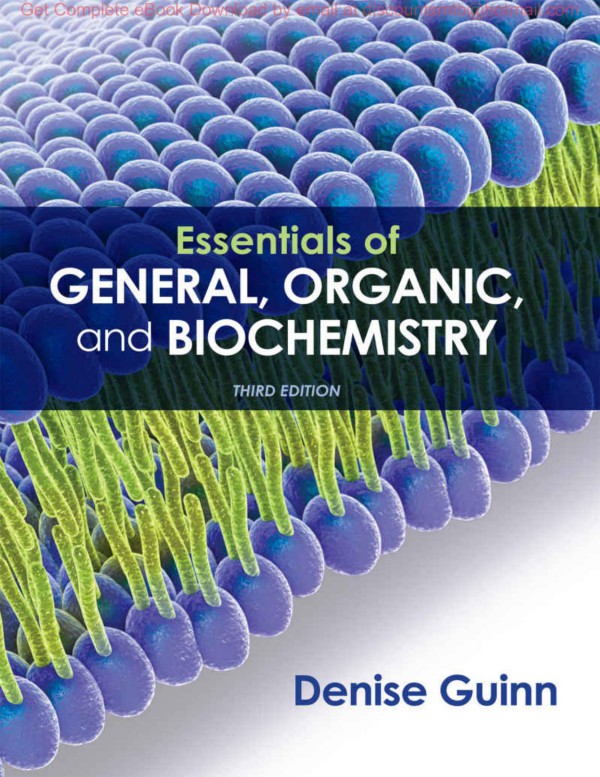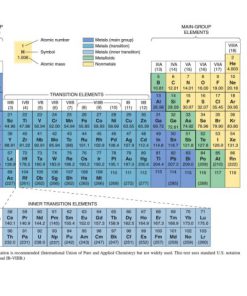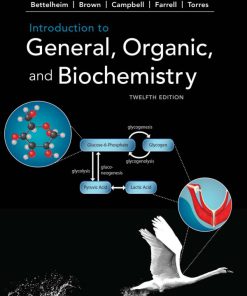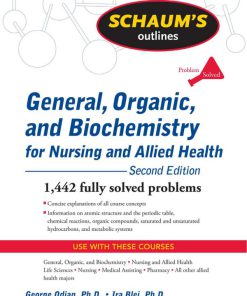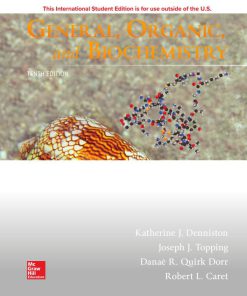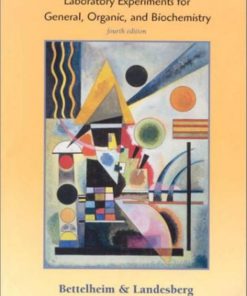(Ebook PDF) Essentials of General Organic and Biochemistry 3rd edition by Denise Guinn 131907944XÂ 978-1319079444 full chapters
$50.00 Original price was: $50.00.$25.00Current price is: $25.00.
Authors:Denise Guinn , Series:Biochemistry [111] , Author sort:Guinn, Denise , Languages:Languages:eng , Published:Published:Feb 2023 , Publisher:Macmillan
Essentials of General, Organic, and Biochemistry 3rd edition by Denise Guinn – Ebook PDF Instant Download/DeliveryISBN: 131907944X, 978-1319079444
Full download Essentials of General, Organic, and Biochemistry 3rd edition after payment.

Product details:
ISBN-10 : 131907944X
ISBN-13 : 978-1319079444
Author : Denise Guinn
Guinn’s Essentials of General, Organic and Biochemistry uses health and medicine as the framework for learning the fundamentals of chemistry in this student-centered one-semester text. The newly revised 3rd edition focuses on core concepts and necessary math skills, and features a revamped organization to align with traditional course organization and shorter, more condensed chapters. Easily digestible content and medical applications help reduce student anxiety and make chemistry meaningful for students preparing for future careers in nursing and other allied health professions. Paired with SaplingPlus and an embedded eBook, students will be able to focus their study with adaptive quizzing and understand the relevance of chemistry through videos, animations and case studies.
Essentials of General, Organic, and Biochemistry 3rd Table of contents:
Chapter 1: Matter, Energy, and Measurement
1.1 Matter and Energy
Kinetic and Potential Energy
1.2 Units and Measurement
Systems of Measurement
Units of Length, Mass, and Volume
1.3 Significant Figures in Measurements and Calculations
Significant Figures in a Measurement
Exact Numbers
Significant Figures in Calculations
1.4 Dimensional Analysis
Using Dimensional Analysis in Metric-Metric Unit Conversions
English-Metric Conversions
Density Calculations
Dosage Calculations
1.5 Temperature Scales and Conversions
The Temperature Scales
Temperature Conversions
Core Concepts
Key Words
Additional Exercises
Answers to Practice Exercises
Chapter 2: Atomic Structure and Radioisotopes
2.1 Elements and the Structure of the Atom
The Structure of the Atom
Elements and the Periodic Table
Isotopes of an Element
Average Atomic Mass
2.2 Navigating the Periodic Table of the Elements
Groups and Periods
Metals, Nonmetals, and Metalloids
Important Elements in Biochemistry and Medicine
2.3 Electron Arrangement and Valence Electrons
Energy Levels and the Arrangement of Electrons
Valence Electrons and Periodicity
2.4 Radioisotopes: α Decay and β Decay
α Decay
β Decay
Half-Life
2.5 High-Energy Electromagnetic Radiation
Electromagnetic Radiation
Radioisotopes That Emit Gamma Rays
2.6 The Penetrating Power and Biological Effects of Radiation
Penetrating Power of Radiation
Radiation Sickness
Core Concepts
Key Words
Additional Exercises
Answers to Practice Exercises
Chapter 3 Ionic and Covalent Compounds
3.1 Ionic Compounds Containing Monatomic Ions
Monatomic Cations and Anions
Writing the Formula Unit for an Ionic Compound
Writing the Name of an Ionic Compound from Its Formula Unit
3.2 Ionic Compounds Containing Polyatomic Ions
3.3 Covalent Compounds
The Covalent Bond
The Molecular Formula of a Covalent Compound
Naming Simple Binary Covalent Compounds
3.4 Writing Lewis Dot Structures of Covalent Compounds
The Process for Writing Lewis Dot Structures
Core Concepts
Key Words
Additional Exercises
Answers to Practice Exercises
Chapter 4 Molecular Geometry, Polarity, and Intermolecular Forces of Attraction
4.1 Three-Dimensional Shapes of Molecules
Molecular Models
Predicting Electron Geometry and Molecular Geometry
Molecular Geometries of the Atoms in Larger Molecules
4.2 Bond Dipoles and Molecular Polarity
Electronegativity
Bond Dipoles
Nonpolar and Polar Molecules
4.3 Intermolecular Forces of Attraction in a Compound
Dispersion Forces
Dipole–Dipole Forces
Hydrogen Bonding Forces
Core Concepts
Key Words
Additional Exercises
Answers to Practice Exercises
Chapter 5 Chemical Quantities and Introduction to Chemical Reactions
5.1 Counting and Weighing Matter: The Mole
Molecular Mass and Formula Mass
The Mole and Avogadro’s Number
The Mole and Molar Mass
Interconverting between Mass and Number of Particles
5.2 Writing and Balancing Chemical Equations
The Law of Conservation of Mass
Writing a Chemical Equation
Balancing a Chemical Equation
Mole-to-Mole Stoichiometry Calculations
5.3 Types of Chemical Reactions
Combination Reactions
Decomposition Reactions
Single Replacement Reactions
Double Replacement Reactions
Oxidation–Reduction Reactions
Core Concepts
Key Words
Additional Exercises
Answers to Practice Exercises
Chapter 6 Chemical Reactions: Energy, Rates, and Equilibrium
6.1 Energy and Chemical Reactions
Units of Energy: The Nutritional Calorie, calorie (cal), and Joule (J)
Exothermic and Endothermic Reactions
The Calorie Content of Foods
An Overview of Energy and Metabolism in Cells
6.2 Rates of Chemical Reactions
Activation Energy, EA
Factors Affecting the Rate of a Reaction
6.3 Chemical Equilibrium
Reversible Reactions and Equilibrium
Le Châtelier’s Principle
Core Concepts
Key Words
Additional Exercises
Answers to Practice Exercises
Chapter 7 Changes of State and the Gas Laws
7.1 Changes of State
Kinetic Energy versus Intermolecular Forces of Attraction
Energy Transfer and Changes of State
Melting and Boiling Points
Specific Heat
7.2 Properties of Gases and the Gas Laws
Pressure
The Gas Laws
Molar Volume and the Volume-Mole Relationship
7.3 Gas Mixtures and Partial Pressures
Henry’s Law
Core Concepts
Key Words
Additional Exercises
Answers to Practice Exercises
Chapter 8 Mixtures, Solution Concentrations, Osmosis, and Dialysis
8.1 Types of Mixtures
Homogeneous and Heterogeneous Mixtures
8.2 Solutions: Dissolving Covalent and Ionic Compounds in a Solvent
Solvation of Covalent Compounds
Solvation of Ionic Compounds
8.3 Solution Concentration
Preparing a Solution with a Given Concentration
Mass/Volume Concentration
% Mass/Volume Concentration
Molar Concentration
8.4 Solution Dosage Calculations in Medicine
Administering Solutions of Oral Medications
IV Solutions and Flow Rate
8.5 Solution Dilution Calculations
8.6 Osmosis and Dialysis
Diffusion and Crossing the Cell Membrane
Osmosis
Dialysis
Core Concepts
Key Words
Additional Exercises
Answers to Practice Exercises
Chapter 9 Acids and Bases, pH, and Buffers
9.1 Acids and Bases
Acids Produce Hydronium Ions and Bases Produce Hydroxide Ions in Aqueous Solution
The Brønsted-Lowry Theory of Acids and Bases
Strengths of Acids and Bases
9.2 pH
Physiological pH
Kw and the Autoionization of Water
Calculating Hydroxide or Hydronium Ion Concentrations Using the Ion-Product Constant for Water
Calculating pH from the Hydronium Ion Concentration
9.3 Acid-Base Neutralization Reactions
Neutralization Reactions with Hydroxide-Ion-Containing Bases
Hydrogen Carbonate and Carbonate Ion as Bases
9.4 Buffers
Components of a Buffer
The Buffer Equilibrium
The Carbonic Acid/Hydrogen Carbonate Blood Buffer
Core Concepts
Key Words
Additional Exercises
Answers to Practice Exercises
Chapter 10 Introduction to Organic Chemistry: Hydrocarbon Structure
10.1 Introduction to Organic Chemistry and Hydrocarbons
What Is Organic Chemistry?
Introduction to Hydrocarbons
10.2 Alkanes and Cycloalkanes
Conformations of Alkanes
Structural Isomers
Writing and Naming Straight-Chain Alkanes
Writing and Naming Cycloalkanes
10.3 Writing Condensed and Skeletal Line Structures of Alkanes and Cycloalkanes
Writing Condensed Structures
Writing Skeletal Line Structures
10.4 Alkenes and Alkynes
Alkenes
Alkynes
10.5 Aromatic Hydrocarbons
Benzene
10.6 Naming Substituted Hydrocarbons
Naming Substituted Alkanes
Naming Substituted Cycloalkanes
Naming Substituted Alkenes and Alkynes
Naming Substituted Benzenes
Pharmaceuticals: IUPAC, Generic, and Brand Names
Core Concepts
Key Words
Additional Exercises
Answers to Practice Exercises
Chapter 11 Alcohols, Phenols, Thiols, Ethers, and Amines
11.1 Introduction to Functional Groups in Organic Chemistry
The Hydrocarbon Functional Groups
Writing Skeletal Line and Condensed Structures for Molecules with Carbon-Heteroatom Bonds
11.2 Alcohols
Naming Alcohols
Types of Alcohols
Diols, Triols, and Polyols in Nature and Industry
Physical Properties of Alcohols
11.3 Phenols
Phenols in Nature and Industry
Naming Phenols
11.4 Thiols
Naming Simple Thiols
Thiols in Nature and in Industry
11.5 Ethers
Ethers as Anesthetics and Pharmaceuticals
11.6 Amines and Their Chemical Reactivity as Bases
Types of Amines
Physical Properties of Amines
Physiological and Pharmacological Activity of Amines
Amines Are Weak Organic Bases
Core Concepts
Key Words
Additional Exercises
Answers to Practice Exercises
Chapter 12 The Common Carbonyl-Containing Functional Groups
12.1 Introduction to the Carbonyl-Containing Functional Groups
12.2 Aldehydes
Aldehydes in Nature
Naming Aldehydes
12.3 Ketones
Ketones Found in Nature and in Pharmaceuticals
Naming Ketones
12.4 Carboxylic Acids
Identifying a Carboxylic Acid Functional Group
Carboxylic Acids and Carboxylate Ions
Carboxylic Acids in Nature and in Pharmaceuticals
Naming Carboxylic Acids
12.5 Esters
Identifying an Ester Functional Group
Esters in Nature and in Pharmaceuticals
IUPAC Rules for Naming Esters
12.6 Amides
Amides in Nature and in Pharmaceuticals
Naming Amides
Core Concepts
Key Words
Additional Exercises
Answers to Practice Exercises
Chapter 13 Common Organic Reactions in Biochemistry
13.1 Oxidation—Reduction Reactions
Oxidation and Reduction Reactions of Organic Substrates
Oxidation and Reduction of Common Functional Groups
13.2 Esterification, Thioesterification, and Amidation Reactions
Formation of Esters and Thioesters
Amidation Reactions
13.3 Hydrolysis Reactions
Applications of Hydrolysis Reactions
13.4 Hydration and Dehydration Reactions
Hydration Reactions
Dehydration Reactions
Core Concepts
Key Words
Additional Exercises
Answers to Practice Exercises
Chapter 14 Carbohydrates: Structure and Function
14.1 An Overview of Carbohydrates and Their Function
Types of Carbohydrates
14.2 Stereoisomers
Chirality
Enantiomers
Diastereomers: Stereoisomers with More Than One Chirality Center
14.3 The Structures of the Common Monosaccharides
The Chemical Structures of Monosaccharides
The Ring Forms of Monosaccharides
14.4 The Structure of Complex Carbohydrates
Disaccharides
Polysaccharides
14.5 The Role of Oligosaccharides as Cell Markers
Core Concepts
Key Words
Additional Exercises
Answers to Practice Exercises
Chapter 15 Lipids: Structure and Function
15.1 Fatty Acids
Types of Fatty Acids
Shapes and Physical Properties of Fatty Acids
The Delta and Omega Systems
15.2 Triacylglycerols: Energy Storage Lipids
Triacylglycerols as Energy Storage Molecules
The Chemical Structure of Triacylglycerols
15.3 Membrane Lipids: Phospholipids and Glycolipids
The Chemical Structure of Phospholipids and Glycolipids
The Cell Membrane
15.4 Cholesterol, Steroids, and Lipoproteins
Bile Salts
Steroid Hormones
Lipoproteins and Cholesterol
Core Concepts
Key Words
Additional Exercises
Answers to Practice Exercises
Chapter 16 Proteins: Structure and Function
16.1 Amino Acids
pH and Amino Acid Equilibria
Amino Acids and Their Side Chains
The Chirality of Amino Acids
Essential Amino Acids
16.2 Peptides
Peptide Bonds
16.3 Protein Structure
The Primary Structure of a Protein
The Secondary Structure of a Protein
The Tertiary Structure of a Protein
The Quaternary Structure of a Protein
The Four Levels of Protein Architecture Applied to Hemoglobin
Types of Proteins: Fibrous and Globular
Denaturation of a Protein
16.4 Enzymes and Enzyme Inhibitors
The Enzyme-Substrate Complex
pH and Temperature Dependence of Enzymes
Enzyme Inhibitors
Core Concepts
Key Words
Additional Exercises
Answers to Practice Exercises
Chapter 17: Nucleotides and Nucleic Acids
17.1 The Chemical Structure of Nucleotides and Polynucleotides
The Monosaccharide
The Nitrogenous Base
The Monophosphate Ester
Constructing Polynucleotides from Nucleotides
17.2 DNA Structure and Replication
Double Helix Structure of DNA
Genes, Chromosomes, and the Human Genome
DNA Replication
17.3 The Role of DNA and RNA in Protein Synthesis
Transcription: DNA to mRNA
Translation
Genetic Mutations
Core Concepts
Key Words
Additional Exercises
Answers to Practice Exercises
Chapter 18: Energy and Metabolism
18.1 Energy and Metabolism: An Overview
18.2 Carbohydrate Catabolism: Glycolysis and Pyruvate Metabolism
Glycolysis
The Metabolism of Pyruvate
18.3 The Citric Acid Cycle
An Overview of the Citric Acid Cycle
A Closer Look at the Steps of the Citric Acid Cycle
18.4 The Electron Transport Chain and Oxidative Phosphorylation
Where It All Happens: The Mitochondria
The Electron Transport Chain and the Proton Motive Force
Oxidative Phosphorylation: Harnessing the Potential Energy of the Proton Motive Force
Net ATP Production from the Complete Oxidation of Glucose
18.5 β-Oxidation of Fatty Acids
Activation of a Fatty Acid to Fatty Acyl-CoA
β-Oxidation
Core Concepts
Key Words
Additional Exercises
People also search for Essentials of General, Organic, and Biochemistry 3rd:
guinn essentials of general organic and biochemistry 3e
achieve for essentials of general organic and biochemistry
essentials of general organic and biochemistry pdf
essentials of general organic and biochemistry 3rd edition pdf
essentials of general organic and biochemistry 3rd edition
You may also like…
eBook PDF
General Organic Biochemistry 1st edition by Denniston, Topping, Caret 1266748628 9781266748622

